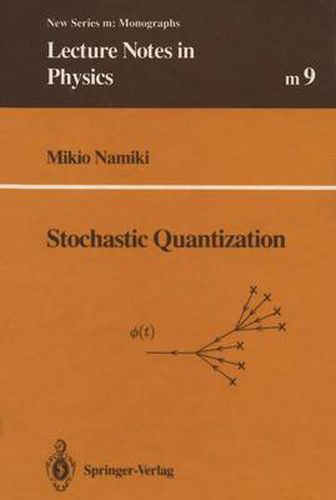Readings Newsletter
Become a Readings Member to make your shopping experience even easier.
Sign in or sign up for free!
You’re not far away from qualifying for FREE standard shipping within Australia
You’ve qualified for FREE standard shipping within Australia
The cart is loading…






This title is printed to order. This book may have been self-published. If so, we cannot guarantee the quality of the content. In the main most books will have gone through the editing process however some may not. We therefore suggest that you be aware of this before ordering this book. If in doubt check either the author or publisher’s details as we are unable to accept any returns unless they are faulty. Please contact us if you have any questions.
This is a textbook on stochastic quantization which was originally proposed by G. Parisi and Y. S. Wu in 1981 and then developed by many workers. I assume that the reader has finished a standard course in quantum field theory. The Parisi-Wu stochastic quantization method gives quantum mechanics as the thermal-equilibrium limit of a hypothetical stochastic process with respect to some fictitious time other than ordinary time. We can consider this to be a third method of quantization; remarkably different from the conventional theories, i. e, the canonical and path-integral ones. Over the past ten years, we have seen the technical merits of this method in quantizing gauge fields and in performing large numerical simulations, which have never been obtained by the other methods. I believe that the stochastic quantization method has the potential to extend the territory of quantum mechanics and of quantum field theory. However, I should remark that stochastic quantization is still under development through many mathematical improvements and physical applications, and also that the fictitious time of the theory is only a mathematical tool, for which we do not yet know its origin in the physical background. For these reasons, in this book, I attempt to describe its theoretical formulation in detail as well as practical achievements.
$9.00 standard shipping within Australia
FREE standard shipping within Australia for orders over $100.00
Express & International shipping calculated at checkout
This title is printed to order. This book may have been self-published. If so, we cannot guarantee the quality of the content. In the main most books will have gone through the editing process however some may not. We therefore suggest that you be aware of this before ordering this book. If in doubt check either the author or publisher’s details as we are unable to accept any returns unless they are faulty. Please contact us if you have any questions.
This is a textbook on stochastic quantization which was originally proposed by G. Parisi and Y. S. Wu in 1981 and then developed by many workers. I assume that the reader has finished a standard course in quantum field theory. The Parisi-Wu stochastic quantization method gives quantum mechanics as the thermal-equilibrium limit of a hypothetical stochastic process with respect to some fictitious time other than ordinary time. We can consider this to be a third method of quantization; remarkably different from the conventional theories, i. e, the canonical and path-integral ones. Over the past ten years, we have seen the technical merits of this method in quantizing gauge fields and in performing large numerical simulations, which have never been obtained by the other methods. I believe that the stochastic quantization method has the potential to extend the territory of quantum mechanics and of quantum field theory. However, I should remark that stochastic quantization is still under development through many mathematical improvements and physical applications, and also that the fictitious time of the theory is only a mathematical tool, for which we do not yet know its origin in the physical background. For these reasons, in this book, I attempt to describe its theoretical formulation in detail as well as practical achievements.